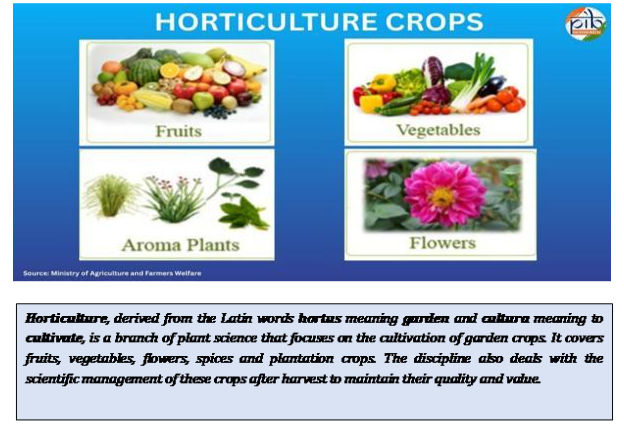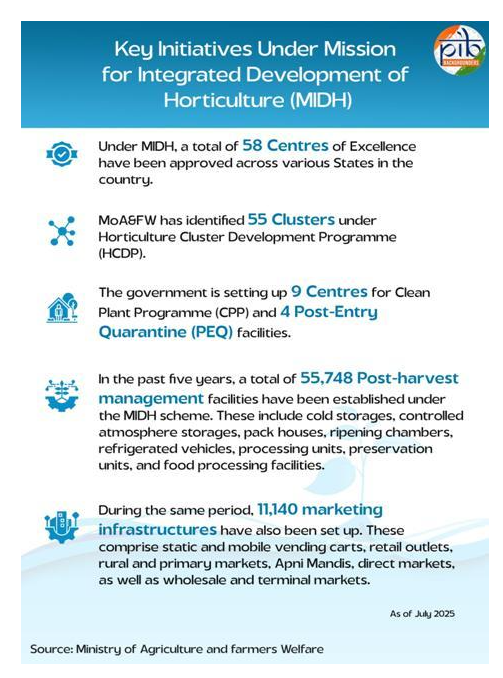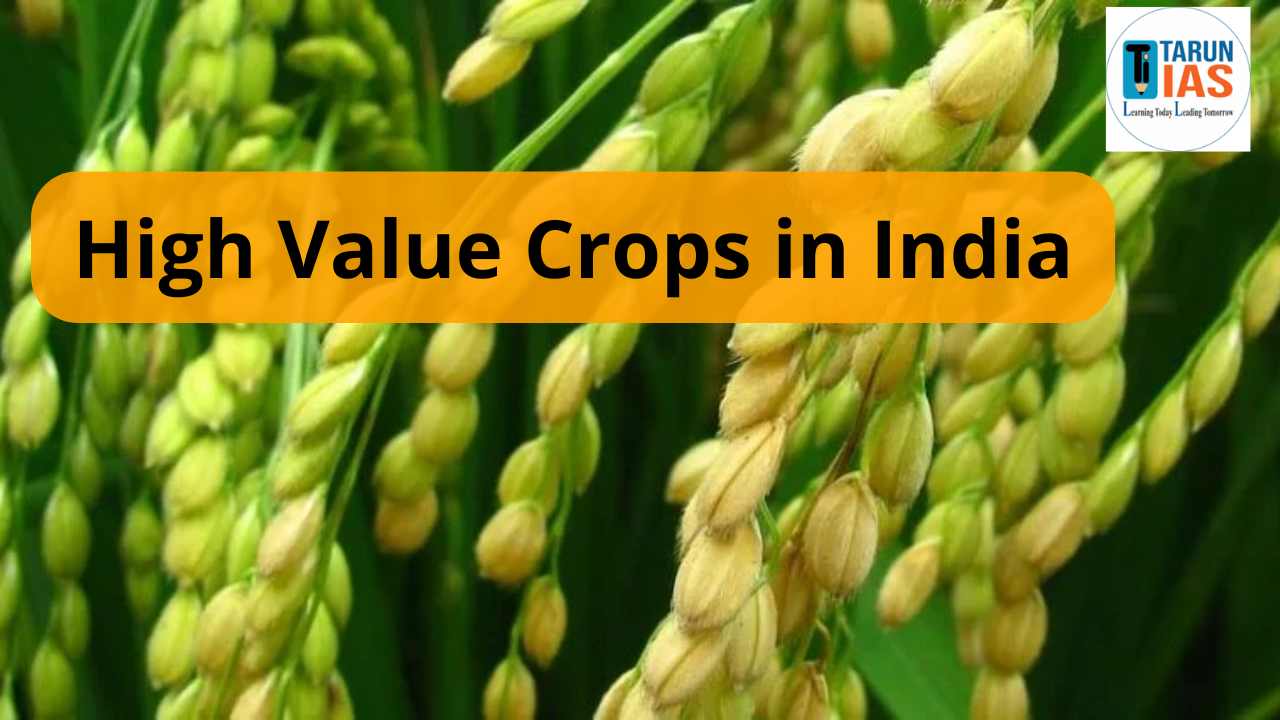High Value Crops in India
- With Punjab facing severe groundwater depletion and declining profitability from the conventional wheat–paddy cropping cycle, farmers are gradually shifting towards horticulture.
- Among High Value Crops (HVCs), dragon fruit cultivation is steadily gaining ground as a lucrative option.
- High Value Crops (HVCs) primarily include horticulture-based produce such as fruits, vegetables, spices, flowers, and aromatic or medicinal plants.
- Unlike staple cereals, these crops generate higher output value and greater net returns, making them central to agricultural diversification and rural income growth in India and globally.

Key Features of High Value Crops
- Intensive Cultivation and Management: These crops require specialized agricultural practices such as precision irrigation, greenhouse or polyhouse farming, vertical farming, and advanced pest management. They demand more labour, skilled supervision, and investment than traditional crops.
- Perishable Nature: Many HVCs, including berries, leafy greens, and fresh herbs, are highly perishable. This necessitates robust cold storage, supply chain infrastructure, and efficient logistics to ensure that the produce reaches markets and consumers without quality deterioration.
- High Market Price: High Value Crops command a premium price due to their superior quality, nutritional benefits, uniqueness, or limited availability. For instance, saffron, exotic fruits like kiwi, or organic vegetables often secure higher prices in both domestic and international markets.
- Niche and Specialty Market Demand: HVCs are often targeted at specialized consumer bases such as fine-dining restaurants, organic food retailers, wellness and nutraceutical industries, or direct-to-consumer platforms. Their demand is also growing due to rising health awareness and changing dietary preferences.
- High Profitability per Unit Area: Even though HVCs are cultivated on smaller land parcels, the profit per acre/hectare is significantly higher compared to staple food grains. This characteristic makes them particularly attractive for small and marginal farmers seeking to maximize income from limited landholdings.
Examples of High Value Crops in India
- Fruits: Fruits dominate the HVC segment due to strong consumer demand and export potential. Common examples include:
-
-
- Pomegranate – widely exported and valued for high nutritional benefits.
- Dragon Fruit – an emerging exotic crop with growing demand in domestic and international markets.
- Black Rice – rich in antioxidants, marketed as a “superfood.”
- Baby Corn – a high-value export-oriented crop.
- Mango, Grapes, Guava, Oranges – traditional fruit crops with both domestic consumption and export significance.
- Vegetables: Vegetables form the backbone of daily nutrition markets and export earnings:
- Tomatoes, Onions, Okra (Ladyfinger), and Capsicum – widely cultivated with strong local and global demand.
- Baby Corn – cultivated for both domestic processing and international export markets.
-
- Flowers and Ornamental Plants: Floriculture contributes significantly to India’s horticulture exports:
-
-
- Marigold – used extensively for religious, decorative, and cosmetic purposes.
- Rose – in demand for perfumery, essential oils, and export markets.
- Orchids – high-value ornamentals with niche demand in international trade.
-
- Spices and Condiments: India’s traditional strength lies in spices, many of which qualify as HVCs:
-
-
- Saffron – one of the world’s most expensive spices, cultivated mainly in Kashmir.
- Cardamom, Turmeric, Ginger, Black Pepper, Chili – globally traded spices that form the backbone of India’s spice economy.
- Medicinal and Aromatic Plants: High demand from pharmaceuticals, nutraceuticals, and wellness industries makes this category lucrative:
- Ashwagandha and Shatavari – used extensively in Ayurveda and herbal medicine.
- Mushrooms (especially Ganoderma species) – valued for medicinal and dietary properties.
- Ginseng – a globally popular herb for energy and immunity enhancement.
- Oilseeds: Select oilseed crops fall into the high-value bracket due to their nutritional and industrial applications:
- Sunflower – important for edible oil and health foods.
- Groundnut (Peanut) – used in multiple forms, from edible oil to snack products.
- Almond – a premium nut crop with high export demand.
-
- Specialty and Export-Oriented Crops: Certain niche crops fetch premium returns in international markets:
-
- Cotton – a key export commodity with strong global demand.
- Organic Herbs – including basil, thyme, oregano, and others for the global organic market.
- Exotic Vegetables – such as broccoli, zucchini, and lettuce, grown for high-end retail and export.
Significance of High Value Crops in Indian Agriculture
- Doubling Farmers’ Income: High Value Crops generate significantly higher returns per acre compared to staple crops like rice or wheat. By enabling farmers to earn more from smaller landholdings, HVCs directly support India’s national vision of doubling farmer incomes. For smallholders, the shift to HVCs can mean better profitability, enhanced livelihood security, and reduced dependence on government subsidies.
- Driving Agricultural Diversification: Moving land away from low-value staples to high-return crops such as fruits, vegetables, and spices creates a more resilient agricultural system. Diversification reduces farmers’ risks against market fluctuations, helps stabilise incomes, and aligns production with evolving consumer demand. This strategic shift also prepares Indian agriculture to better withstand climatic variability and unforeseen shocks.
- Generating Employment Opportunities: HVCs are labour-intensive, requiring significant workforce input across the value chain—cultivation, harvesting, grading, processing, packaging, and marketing. This labour demand generates both on-farm and off-farm employment, particularly benefiting women and rural youth. Moreover, the rise of agro-processing industries and supply chains around HVCs strengthens rural non-farm employment and contributes to regional development.
- Expanding Export Potential: India’s high value crops such as mangoes, pomegranates, spices, and medicinal herbs enjoy strong international demand. Enhanced focus on quality improvement, certification, and value addition can further boost India’s agricultural exports and foreign exchange earnings. With the global demand for organic and exotic produce rising, HVCs position India as a competitive supplier in world markets.
- Supporting Sustainable Development: HVCs contribute to sustainable farming practices in multiple ways:
- Many crops can be grown in rainfed or less fertile lands, ensuring optimal use of marginal areas.
- Perennial and medicinal plants improve soil fertility, enhance biodiversity, and reduce dependence on chemical inputs.
- Their cultivation supports climate resilience, making agriculture more adaptive to changing environmental conditions.
Government Initiatives to Promote High Value Crops (HVCs)
- Mission for Integrated Development of Horticulture (MIDH): The MIDH scheme is the flagship programme to support horticulture expansion. It focuses on:
- Area Expansion & Improved Varieties: Promotes the adoption of high-yielding hybrids and exotic crops.
- Subsidies for Planting Materials: Farmers receive financial support for crops like cashew, cocoa, moringa, hybrid vegetables, and perennial spices.
- Water Resource Development: Investments in irrigation structures and micro-irrigation facilities.
- Protected Cultivation: Encourages greenhouses, polyhouses, and net houses for high-value and off-season production.
-
- Operation Greens: Launched initially for Tomato, Onion, and Potato (TOP) crops, this scheme was later expanded to cover all fruits and vegetables. Its interventions include:
- Price Stabilisation: Protects growers against distress sales during glut seasons.
- Post-Harvest Management: Provides financial assistance for cold storage, grading, and processing facilities.
- Logistics and Market Linkages: Support for transportation and value-addition infrastructure to strengthen supply chains.
- Operation Greens: Launched initially for Tomato, Onion, and Potato (TOP) crops, this scheme was later expanded to cover all fruits and vegetables. Its interventions include:

- Horticulture Cluster Development Programme: This programme adopts a cluster-based approach, focusing on specific geographic areas to enhance productivity and market orientation. Key features include:
- Development of market-driven crop clusters for export competitiveness.
- Infrastructure support for grading, sorting, pack-houses, and logistics.
- Promotion of modern technologies for improved quality and productivity.
- Horticulture Cluster Development Programme: This programme adopts a cluster-based approach, focusing on specific geographic areas to enhance productivity and market orientation. Key features include:
- Role of the National Horticulture Board (NHB): The NHB complements central schemes by facilitating:
-
-
- Establishment of nurseries, pack houses, cold storage, and ripening chambers.
- Support for Bharat GAP certification to ensure food safety and export-quality standards.
- Strengthening of backward and forward linkages for horticulture farmers.
-
- Transport Support: Kisan Rail and Kisan Udaan: To address perishability and high logistics costs, the government has launched:
-
-
- Kisan Rail: Special trains dedicated to transporting fruits, vegetables, and perishables quickly to distant urban and export markets.
- Kisan Udaan: Air cargo services for high-value horticultural produce, particularly from North-Eastern and tribal areas.
- Farmers benefit from up to 50% transportation subsidy, reducing costs and widening market access.
-
- Price Support and Remuneration Schemes: To ensure profitability and resilience against market volatility, the government has extended support through:
-
- Minimum Support Price (MSP): Fixed at 1.5 times the average production cost for pulses, oilseeds, nutri-cereals, and select commercial and horticultural crops.
- Price Deficiency Payment Scheme (PDPS): Provides direct compensation when market prices fall below MSP.
- Market Intervention Scheme (MIS): Helps stabilise prices of perishable horticulture commodities.
Way Forward
- Strengthening Market Linkages and Infrastructure:
-
-
- Expanding Market Access: Farmers need direct access to organised markets, contract farming arrangements, and digital trading platforms like e-NAM to reduce dependence on intermediaries.
- Infrastructure Support: Large-scale investment in cold chains, pack-houses, grading units, and efficient logistics systems is essential to minimise post-harvest losses and enhance farmer bargaining power.
-
- Promoting Technology Adoption and Extension Services:
-
-
- Advanced Agronomy: Wider outreach and training on precision farming, integrated pest management, and protected cultivation (greenhouses, polyhouses) can improve productivity and quality.
- Demonstration and Research: Centres of Excellence and demonstration farms should be scaled up to act as hubs for capacity building, technology transfer, and farmer training.
-
- Expanding Credit and Financial Support:
-
-
- Access to Credit: Strengthening timely and affordable credit facilities, coupled with targeted subsidies and crop insurance, will support farmers cultivating HVCs.
- Value Addition Investments: Greater incentives for processing, packaging, and value-addition enterprises can generate higher returns and expand rural employment opportunities.
-
- Enhancing Risk Management and Climate Resilience:
-
-
- Insurance Expansion: Crop insurance schemes must specifically cover horticultural and high-value crops to protect farmers from price shocks and natural calamities.
- Climate-Resilient Crops: Promoting short-duration, drought-resistant, and water-efficient varieties is crucial, especially for smallholders in rainfed and marginal areas.
-
- Strengthening Policy and Institutional Support:
-
-
- Reforms for Aggregation: Support policies that enable land pooling, farmer producer organisations (FPOs), and direct marketing models for scaling up production and improving competitiveness.
- Extension Services: Create robust extension networks for grading, certification, and export facilitation to make HVCs globally competitive.
-
- Focus on Quality Standards and Export Promotion:
-
- Certification Support: Enhance farmer access to quality certification, grading, and phytosanitary standards, which are essential for domestic and export markets.
- Market Intelligence and Branding: Strengthen real-time market intelligence systems and invest in branding of Indian high-value crops such as mangoes, spices, and medicinal herbs for global recognition.














